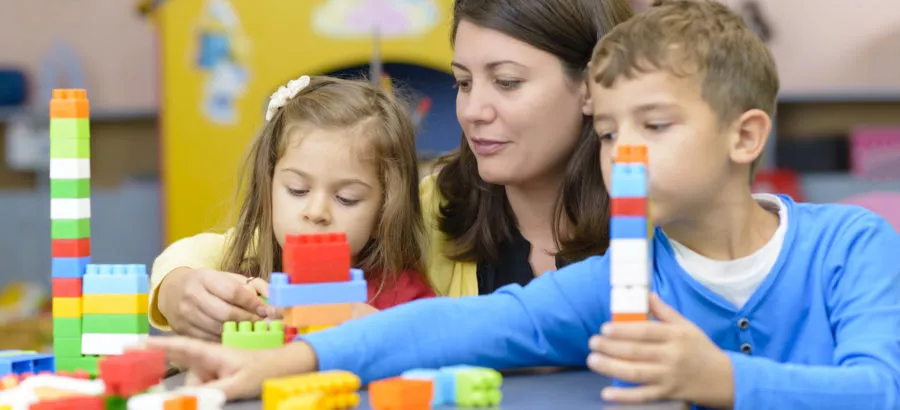Play is the work of children, Fred Rogers of Mr. Roger’s Neighborhood always reminded us. But over the past two decades, the American kindergarten experience has become much more academic—at the expense of play.
During the era of testing, NCLB and the Common Core Standards, kindergarten has morphed from a time of play and discovery into the new first grade, where children read and write, do simple math, and even learn to take standardized tests.
“We need to bring more play back into the day,” says Sharon Davison, a Vermont kindergarten teacher. “Children experience authentic experiences with leadership, collaboration and deep problem solving through play.”
Many classrooms are sacrificing the discovery and critical thinking skills that arise through play in favor of academics, researchers at the University of Virginia found, led by the education-policy researcher Daphna Bassok. Between 1998 and 2010, they found kindergarten classes across the country had become more focused on academics, with a particular focus on advanced literacy skills more typical of first grade classrooms.
In the study, the percentage of kindergarten teachers who reported that they agreed (or strongly agreed) that children should learn to read in kindergarten greatly increased from 30 percent in 1998 to 80 percent in 2010.
“We are too quick to push the academics; we need to focus on what our students need first,” says Wyoming kindergarten teacher Dirk Andrews. “Through play I can incorporate social skills, language development, beginning reading and writing skills, and develop a love for math.”
There is a huge misconception out there that when students are playing they are not learning, Andrews says.
“This couldn’t be further from the truth. So much of a child's learning is constructed through play,” he says. “Children learn best through play because it allows them to apply everything they know and encourages them to ask questions and seek out new information and discovery.”
According to the report, Crisis in Kindergarten, the power of play as the engine of learning in early childhood and as a vital force for young children's physical, social, and emotional development is beyond question, yet play is rapidly disappearing from kindergarten and early education as a whole.
“Every child deserves a chance to grow and learn in a play-based, experiential preschool and kindergarten. Play works,” the authors write.
We laud Finland’s education system for good reasons – they have highly trained, well respected and well compensated educators, they consistently rank among the highest performers on international tests like PISA, and they also have a successful approach in educating its youngest students. They focus on play.
“Kindergartners” in Finland are usually six years old, and they spend large chunks of their day engaged in play. According to an Atlantic Monthly article, there is no typical day in a Finnish kindergarten.
"Instead of a daily itinerary…[there is] a weekly schedule with no more than several major activities per day: Mondays, for example, are dedicated to field trips, ballgames, and running, while Fridays—the day I visited—are for songs and stations."
"Once, Morning Circle—a communal time of songs and chants—wrapped up, the children disbanded and flocked to the station of their choice: There was one involving fort-making with bed sheets, one for arts and crafts, and one where kids could run a pretend ice-cream shop."
But the Finnish teachers point out that there is learning happening. The pretend ice cream shop has a price list and pretend money. Educators help the children learn the concept of money, price and change – math.
In Finland’s kindergarten classes, there is free-form, child-directed play, much of it done outside. (Children spend at least 90 minutes of the day playing outside, and schools are equipped with industrial sized dryers for wet winter clothes.) But, like in the ice cream shop, there is guided, pedagogical play, but it’s fun and it doesn’t feel like a lesson.
“Kindergarten in Finland doesn’t focus on preparing children for school academically,” writes the Finnish educational expert Pasi Sahlberg. “Instead the main goal is to make sure that the children are happy and responsible individuals.”
The homogeneous schools in Finland and and the melting pot schools in America are apples and oranges, to be sure, but there are lessons we can learn and apply at home – lessons some early educators are already practicing, like Vermont’s Sharon Davison.
Davison incorporates play into each day and allows students to choose what their activities will be.
“The choice is one of the most important ideas in play because students choose what they are curious about and create play based on what they want to know,” she says. “Children experience authentic experiences with leadership, collaboration and deep problem solving through play.”
But she also guides some of their play in concrete lessons. For example, her students learn about hunger. As a class they wondered, are people hungry, are all children provided with enough food?
The students created a food shelf in the classroom, like a real food pantry for families and children in need, which they stocked twice a year with food items they brought from home. That food was then delivered to a local food pantry. It was fun and exciting, and there was authentic learning happening at the same time.
“Through their play they experience empathy, collaboration, and kindness,” Davison says. “Leadership skills emerge and empathy grows.”


